I know that many of you really have enjoyed my pouch-projects and I guess that some of you miss my “old” fast and easy pouch tutorial. Therefore I started a new project for you and also for my “Craft with Racaire” section:
My fast and easy pouch tutorial

Before I introduce you the more difficult techniques and we start with the embroidered and fancy pouches, I decided to show you a simple way how to make a hand-sewn pouch for yourself, for a gift, your favorite card game,… or whatever you want to store in it. Btw. this is a tutorial for a hand-sewn pouch which you can easily embroider and embellish. It also makes a rather fast and easy but also impressive gift, especially when you add some bling (like self-made tassels) to it.
The following tutorial is the fastest and most “easy” pouch tutorial I can imagine when it comes to hand-sewn pouches. It is suitable for beginners to sewing as well as for advanced sewers. For the beginners among you I will soon add some information about period sewing techniques and stitches you will need to sew and complete this project. And the advanced embroiderers and hand-sewers might enjoy my detail-work and will maybe draw some inspiration for “fast & easy” future projects. Regardless on which level you are, I heartily welcome all of you to join me in this project.

Btw. both pouches on the picture on the left – the bigger gaming pouch as well as the small red pouch – are based on the same basic pattern. There is just a small difference concerning the sewing part. I will tell you more about this small variation as soon as we come to the part that differs.
Like during my very first project for “Craft with Racaire” – project #1 – needle roll 1 – I will do my best to lead you carefully and step by step through the tutorial. Btw. I am very looking forward to seeing pictures of your finished pouches based on this tutorial as soon as you finish them. 🙂
…and here some of the sneak peek pictures I already posted to give you an idea of what we are going to create this time:
The pictures from my first posting:
“Sneak peek – hand sewing a pouch for my 14th century inspired Backgammon Game“.
The pictures from my second posting:
“Sneak peek – more progress pictures of my 14th century inspired gaming pouch“.
I hope you enjoyed all this nice sneak peeks of the upcoming project. Now it is time to finally start with our project – lets start with the usual list of the materials you will need for your project:
Step 1 – the required materials for my
fast and easy pouch tutorial
[emember_protected not_for=4 do_not_show_restricted_msg=1]
…I am sorry, but the following content is restricted to users with Premium membership.
Because no embroidery is involved this time, you will need less to get started than for our first project, the embroidered needle-roll:
 Fabric – for the size see the chart & calculation example underneath
Fabric – for the size see the chart & calculation example underneath- “strong” thread – for sewing
- 1 sewing needle & 1 good pair of scissors
- Thread for the tassels and the cords – cotton, silk or wool, in any color you wish
- A pair of tongs – they are not really necessary but can be very handy when you work at the tassels and other projects where you have to pierce through something tight or firm
Before we can start with the project, you will need a piece of rectangular fabric – point #1 on our list of required materials above. As you can see on the picture above,I used for this pouch a fabric with a special “rapport” (= repeatin pattern/design). Therefore I orientated the size of my pouch on this rapport.
Well, if you work with a rapport there are some Pros and Cons. I think I should outline for you some of them in case you have some nice fabric with a repeating pattern and would like to use it.
Rapports
(repeating patterns/designs)
Pros & Cons …and how to work with them
The positive side of nice rapports is that they are beautiful and can be impressive if used right. That also brings us fast to the not so positive side – this right “use” of a nice rapport includes more consideration and work than just plain fabric. A repeating pattern which is quite big can make you rather dependent on the size of the repeating pattern.
Just take the pouch on the picture above as example and you will see what I mean. The pattern is quite big and would not come out as nicely on a smaller pouch as it does on the pouch above. That also means that you will not be free to choose your pouch size unrestricted unless you don’t care much about your rapport or are willing to cut through parts of it – something that seldom can be avoided in such cases.
Furthermore, if you have such a nice fabric, as I used for the pouch, you normally don’t have a lot of it and if some fabric is left afterwards, you want to be able to also use the leftover fabric and the pattern on it. Yes, there are so many things that should be taken into consideration when working with nicely patterned fabric – especially concerning fabric with rather big rapports.
Nevertheless, when you have a nice rapport, I highly recommend to find or at least estimate the middle of your pattern and measure all your measurements from this point.
This way you can put the most beautiful and/or interesting part of the pattern/design into the center of your pouch. From this “middle” point you can easily apply your measurements by measuring 50% of your width/height to the left (and/or top) and the same measurement to the right (and/or bottom). Working “from the center”, you can manage to put your pattern into the spot-light by centering it on your pouch.
While you are centering your pattern, you should not only focus on left and right or top and bottom, you should also keep all other sides in mind. Also a look at your back side can be helpful from time to time. Don’t forget that as long as you didn’t cut the fabric, you can still alter your measurements if it appears to you that your pouch and pattern would benefit from an alteration.
…and now to the calculation for the pouch:
[emember_protected not_for=2-4-7 do_not_show_restricted_msg=1]
…I am sorry, but the following content is restricted to users with Premium membership.
As you can see on the picture underneath, I drew a chart for you to illustrate which measurements you need to calculate the dimensions for your personal pouch based on your needs and preferences.
Btw. I base the numbers for the following calculation on the numbers I use for the 14th century French pouch commission I am working at at the moment. The fabric size you will get at the end of our calculation should is suitable for a nice “medium” pouch.

For the Width:
1 = desired final width of your pouch
2 & 2a = 2x seam allowance*
* = My seam allowance is normally about 5mm (0.5cm / 0.2in) – because this seam will be “rolled in” to prevent fraying, we will need it two times per side => 1cm / 0.4in per side.
Width calculation – for example:
1 + 2 + 2a = your fabric width
-> 26 + 1 + 1 = 28cm
-> 10.2 + 0.4 + 0.4 = 11in
For the Height:
4 & 4a = desired height of your pouch
3 & 3a = 2x height of drawstring casing**
5 & 5a = seam allowance (see * above)
** = Well, the drawstring casing will depend on the size of your pouch but usually for a pouch with a height of about 18cm / 7.1in a drawstring casing about 2cm / 0.8in should be enough – if you make a bigger or smaller pouch you can enlarge or reduce this number according to your preferences.
For 3 or 3a we have to double the number because every casing has a front and a back side => 4cm / 1.6in per side
Height calculation – for example:
4+4a + 3+3a + 5+5a or ( 4 + 3 + 5 ) x 2= your fabric height
-> 18+18 + 4+4 + 1+1 or ( 18 + 4 + 1) x 2 = 46cm
-> 7.1+7.1 + 1.6+1.6 + 0.4+0.4 or (7.1 + 1.6 + 0.4) x 2 = 18.2in
Well, as you can see, just a little bit of calculation and you can measure and cut your fabric and we can start with the next step.
In the next posting I will show you the first sewing steps to your new finished pouch.
I hope you enjoyed this posting with the first instructions for our second “Craft with Racaire” project – my fast and easy pouch tutorial. More will follow soon, I promise. 🙂





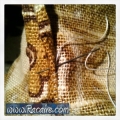
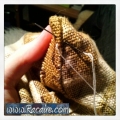
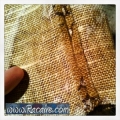




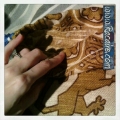

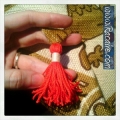


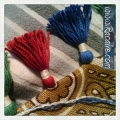
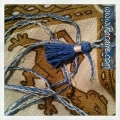


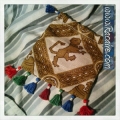


You must be logged in to post a comment.